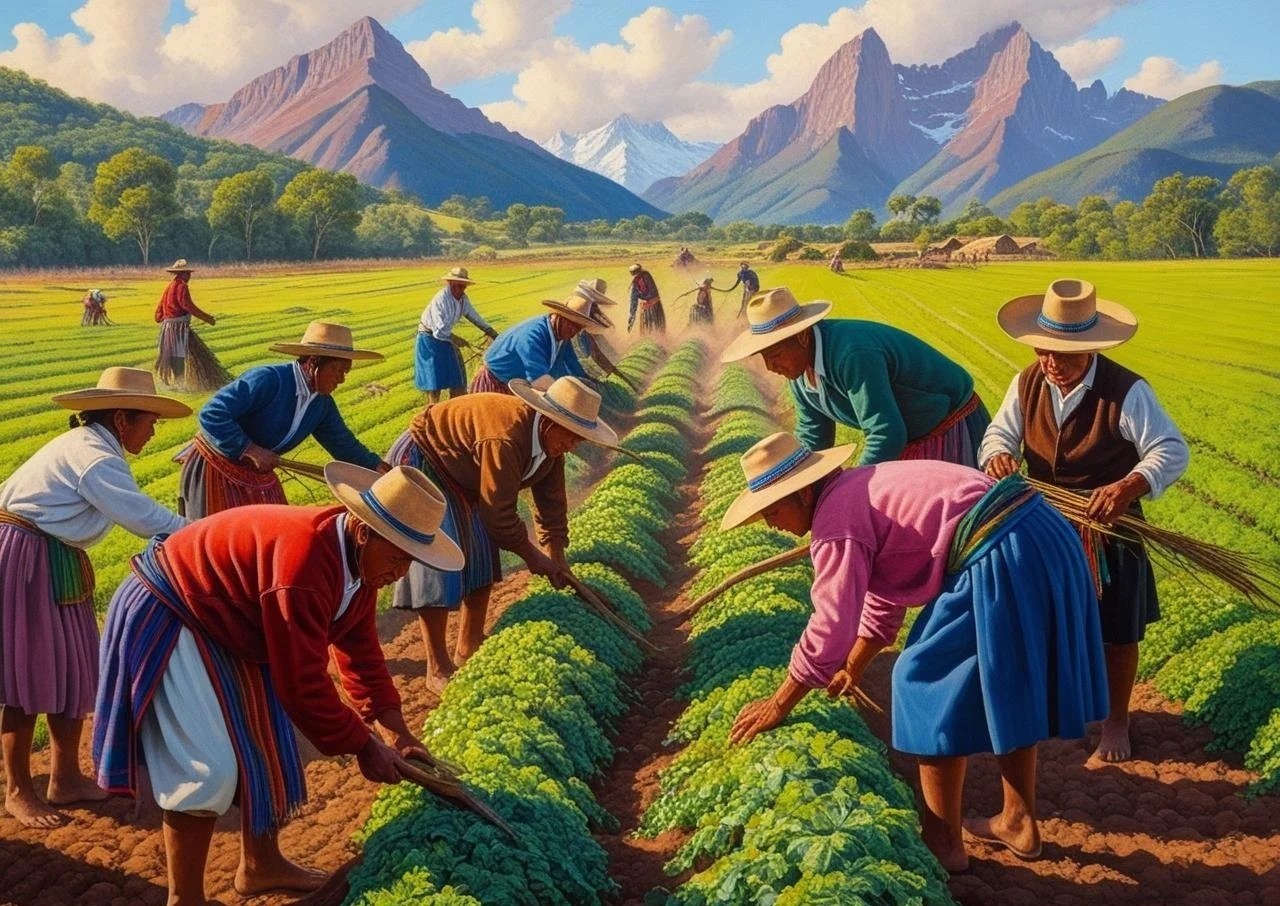Resilient By Design
Resilient by Design is a journal of exploration into the inherent resilience of the world around us—how systems naturally adapt, regenerate, and thrive by design. It invites you to uncover these awe-inspiring patterns of existence and rewrite our personal and collective narratives with wisdom, strength, and intention.
Articles by Pillar
Everything is connected.
Everything is connected.
The Andean Ayni: A Tradition of Reciprocity and Harmony
In the rugged landscapes of the Andes, where survival depends on resilience and collaboration, the Quechua concept of ayni has flourished for centuries. Rooted in a profound understanding of reciprocity, ayni embodies the principle of mutual exchange: “Today for you, tomorrow for me.”
Passive Cooling in Persia: Harnessing the Wind to Beat the Heat
In the arid deserts and sun-scorched cities of ancient Persia, where temperatures soared to unbearable extremes, architects devised a brilliant solution to keep homes and public spaces cool: wind catchers, or badgirs. These simple yet ingenious structures used the power of natural airflow to provide cooling and ventilation, long before the advent of modern air conditioning.
The Mudbrick Cities of Mesopotamia: Building Civilizations from the Earth
In the fertile lands between the Tigris and Euphrates Rivers, where the harsh sun baked the earth and rivers carved life into the arid landscape, the civilizations of ancient Mesopotamia arose. Known as the Cradle of Civilization, Mesopotamia gave birth to some of humanity’s greatest advancements—writing, agriculture, and monumental architecture. Central to this development was the humble mudbrick, a material as ancient as the land itself.
Bamboo Architecture of Southeast Asia: Nature’s Blueprint for Resilience
In the lush, humid landscapes of Southeast Asia, where the earth is fertile and the weather often unforgiving, a remarkable tradition of architecture has stood the test of time: bamboo construction.
Three Sisters Farming: A Story of Unity, Resilience, and Respect
Long before modern agricultural science, Indigenous peoples of North America cultivated a method of farming that perfectly harmonized nature’s resources: Three Sisters Farming. This ingenious practice combined corn, beans, and squash in a single plot, where each plant played a unique role in supporting the others. More than a farming technique, it was a lesson in balance, resilience, and respect for the land.
Agroforestry in Africa and the Amazon: Ancient Wisdom, Modern Solutions
Deep in the heart of the Amazon and across the diverse landscapes of Africa, ancient and Indigenous communities mastered a harmonious way of farming: agroforestry. By cultivating crops alongside trees, they created resilient ecosystems that nurtured biodiversity, enriched soil health, and sustained communities for generations. This practice wasn’t just about agriculture—it was a holistic approach to living in balance with nature.
Terraced Fields in the Andes: The Ingenious Agriculture of the Incas
High in the Andes Mountains, where the air is thin and the land steep, the Incas accomplished what many might deem impossible: they turned rugged, mountainous terrain into fertile farmland. Through the construction of terraced fields—step-like platforms carved into the slopes—they mastered the art of high-altitude agriculture, feeding their vast empire and safeguarding the land from the forces of nature.
Maya Reservoirs: Engineering Resilience in the Ancient World
Imagine living in a world of extremes—a place where torrential rains flood the landscape for months, followed by parched skies and scorching heat that bake the earth dry. This was the challenge faced by the ancient Maya, who thrived in the unforgiving climates of Central America. Yet, against these odds, they built flourishing cities, sustained by one of the most sophisticated water management systems of the ancient world.
Stepwells of India: Guardians of Water and Culture
Imagine walking through a parched landscape, the air shimmering with heat and the land cracked from the sun’s relentless grip. Then, in the distance, you see an opening in the earth—a descent of intricately carved steps leading down to a shimmering pool of water, cool and inviting. This is a stepwell, a lifeline carved into stone, defying the harshness of the desert.
The Qanats of Persia: Ancient Engineering for a Thirsty World
In the blistering deserts of Persia, where rain was scarce and the sun unrelenting, ancient engineers devised a remarkable solution to sustain life. They carved qanats—underground aqueducts that transported water across arid landscapes with almost no loss to evaporation. These subterranean marvels, some over 3,000 years old, not only provided water for drinking and agriculture but also fueled the growth of entire cities.
The Ripple Effect of Reforestation: Healing the Planet, One Tree at a Time
In the heart of Ethiopia, where the soil once crumbled into dust and rivers dried to trickles, a single farmer planted a tree. Then another. Slowly, others joined in, and within a few years, an entire hillside transformed into a thriving forest. Streams began to flow again, crops grew stronger, and wildlife returned.
Protecting Water Resources: Steps for a Sustainable Future
Water is life. From drinking water to agriculture, industry, and ecosystems, clean water sustains every aspect of human and natural life. Yet, water resources are under increasing pressure from pollution, overuse, and climate change. Over two billion people lack access to safe drinking water, and countless ecosystems are at risk due to degraded water systems.
Combat Plastic Pollution: Simple Actions for a Cleaner Future
Every minute, the equivalent of a garbage truck’s worth of plastic is dumped into the ocean. From the mountains to the deep sea, plastic pollution has infiltrated every corner of the planet. This crisis isn’t just about unsightly litter—it’s choking marine life, disrupting ecosystems, and even entering our food chain.
How to Reduce Your Carbon Footprint
The term carbon footprint refers to the total amount of greenhouse gases, primarily carbon dioxide (CO₂), emitted by your daily activities. From the energy we use to the food we eat, our choices directly affect the planet. Reducing your carbon footprint isn’t just about combating climate change—it’s about creating a healthier, more sustainable future for all.
How to Support Biodiversity: Immediate Actions for a Healthier Planet
Imagine a world without the hum of bees, the flutter of butterflies, or the song of birds at dawn. These seemingly small creatures play an outsized role in sustaining life on Earth.
Coral Reef Restoration: Reviving the Rainforests of the Sea
Often called the “rainforests of the sea,” reefs support 25% of all marine life, from tiny shrimp to majestic sea turtles and sharks. They are critical to global biodiversity, coastal protection, and livelihoods for millions of people.
The Greening of the Sahel: A Desert Reborn
In the heart of Africa, where the arid sands of the Sahel meet the Sahara, a remarkable transformation is underway. Once plagued by desertification, this semi-arid region is now witnessing a revival of life.
Rewilding in Europe: Restoring Nature’s Balance
Rewilding initiatives are bringing species back from the brink of extinction, revitalizing landscapes, and teaching us that nature can heal when given the chance.
Plastic Pollution: Turning the Tide on an Ocean Crisis
Every year, over 8 million tons of plastic enter our oceans, polluting ecosystems and endangering countless species. From microscopic plankton to whales the size of buses, no creature is immune to this human-made crisis.
Biodiversity Collapse: The Looming Threat to Life on Earth
Imagine a lush forest where birds, insects, and mammals coexist in a delicate balance, each playing a vital role in the ecosystem. Now, imagine that forest without its pollinators, its apex predators, or its soil-enriching decomposers. What’s left is an ecosystem on the brink of collapse.


























